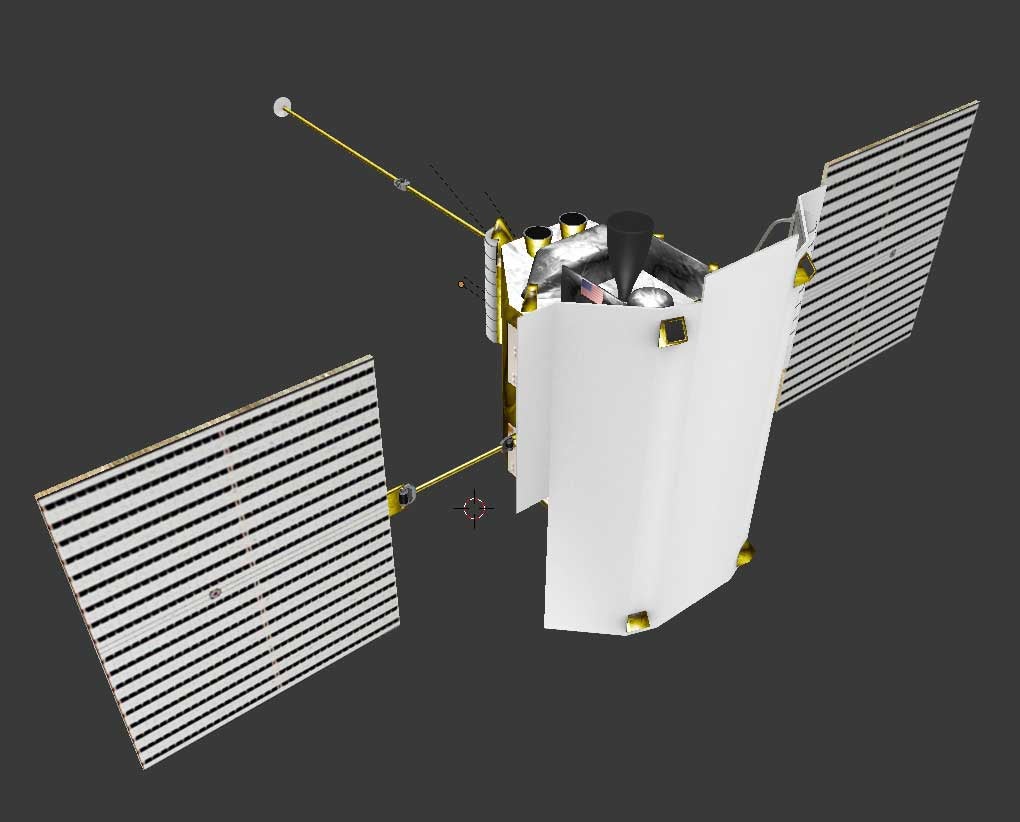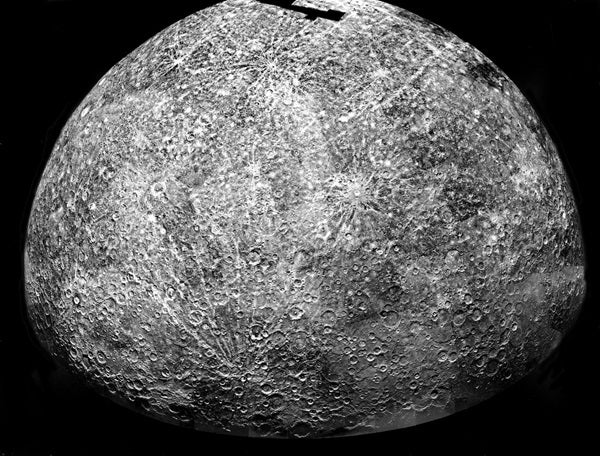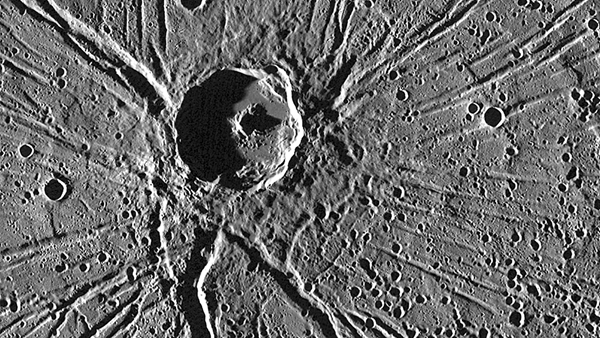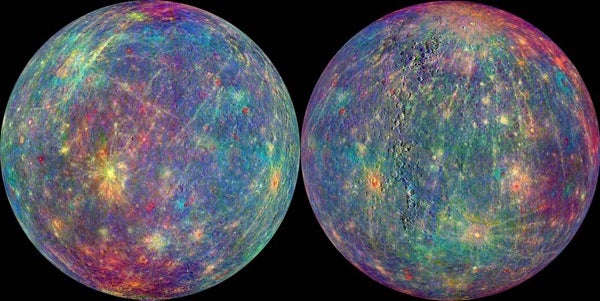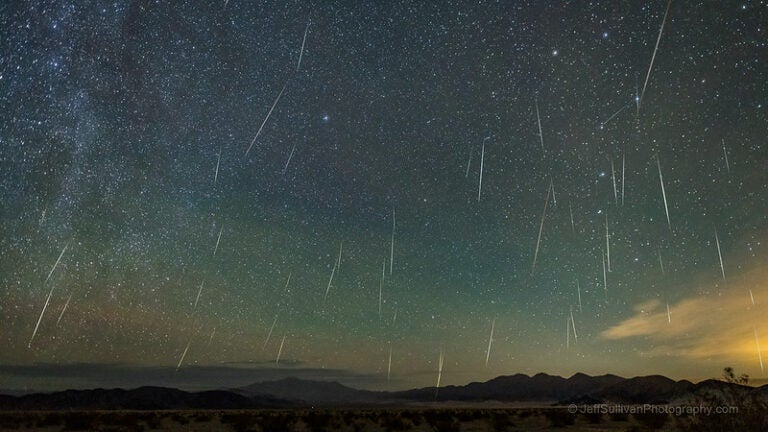To our early ancestors, Mercury was an oddity. The tiniest planet in the sky, it was also the quickest. And its rapid motion across the heavens earned it a measure of repute as the fleet-footed messenger of the gods — from the Babylonian Nabu to the Greek Hermes to the root of its modern name, the Roman Mercurius.
Mercurius’ divine attributes included trickery, thievery, and good fortune. All three of which fell crisply into alignment ten years ago today, when an interplanetary probe called MESSENGER was snatched from space by Mercury’s weak gravity, forever changing our understanding of this little-known world at the solar system’s ragged inner edge.
Mariner 10 scouts Mercury first
MESSENGER was only the second probe to venture to Mercury, and it came three decades after Mariner 10 completed a whistle-stop tour and three close-range flybys between 1974 and 1975. But Mariner 10’s trajectory meant it could only see the diminutive world’s eastern hemisphere. As such, only 45 percent of Mercury’s surface was visible; the rest lay hidden in darkness.
Still, Mariner 10 revealed clues about the barren, broiling world, which sits three times closer to the Sun than Earth. In the coal-black mercurian sky, the Sun appears 11 times brighter and three times bigger than it does on Earth, and it bakes the planet to many times hotter than humans could ever endure.
Mariner 10 saw rugged highlands and smooth lowlands, not unlike the Moon, although their nature differed on account of Mercury’s stronger gravity. Chains and clusters of craters seemed to flank the highlands, and the immense Caloris Basin — a 3.85-billion-year-old impact feature ringed by forbidding mountainous scarps — came teasingly, but only partially, into Mariner 10’s view.
The probe detected Mercury’s tenuous exosphere of hydrogen and helium atoms seized from the solar wind, as well as a massive planetary core rich in iron and nickel. Surface temperatures were found to swing like a searing pendulum, ranging from 750 degrees Fahrenheit (400 degrees Celsius) during the day to –290 degrees Fahrenheit (–180 degrees Celsius) at night. Surprisingly, Mariner 10 also found Mercury has an intrinsic magnetic field, and though it’s a hundred times feebler than Earth’s, it does weakly shield the planet from the charged particles of the solar wind.
Yet, the most improbable discoveries about Mercury came after Mariner 10 was gone. For instance, radar observations revealed bright spots near the tiny planet’s north and south poles that suggested, even in this hellish place, water-ice deposits could survive on the floors of Mercury’s permanently shadowed craters.
Another mission to Mercury was desirable, but inherently difficult.
Reaching the closest planet to the Sun is far tougher than reaching the farthest. That’s because as a probe falls inward toward the Sun, it picks up speed, which would cause it to sweep past Mercury too fast to be captured by its weak gravity. But by swinging by Earth once, Venus twice, and Mercury three times, such a craft would be able to use these planets’ combined gravities to slow itself down enough to gently drop into mercurian orbit.
And that’s exactly the approach MESSENGER took to become the first spacecraft to enter orbit around Mercury.
MESSENGER goes to Mercury
NASA cleverly tailored this spacecraft’s name using their tried-and-true “backronym” technique, where MESSENGER was made to stand for MErcury Surface, Space, ENvironment, GEochemistry, and Ranging. The probe launched atop a Delta II rocket from Cape Canaveral on August 3, 2004.
Standing six feet (1.8 m) high and boasting a graphite-epoxy frame and protective shield made of ceramic fabric, MESSENGER carried seven instruments to probe Mercury. Its cameras would map the planet at resolutions better than 800 feet (250 meters) per pixel. Gamma-ray, X-ray, and neutron spectrometers would seek out polar ice and examine mineralogical features. And other sensors would scan Mercury’s exosphere, study its magnetic field, measure its landforms, and determine the strength of its gravitational field.
After initially barreling away from Earth at 24,000 miles per hour (38,600 km/h), MESSENGER returned to our planet in August 2005, passing high over central Mongolia while calibrating its scientific toolkit. Two encounters with Venus followed in October 2006 and June 2007. MESSENGER then swept within 125 miles (200 km) of Mercury itself three separate times between January 2008 and September 2009.
During those flybys, MESSENGER imaged almost all of Mercury’s previously unseen western hemisphere, capturing 98 percent of the planet’s surface, with only the polar regions remaining out of sight — at least for the time being. It discovered the 440-mile-wide (715-kilometre) Rembrandt crater (one of Mercury’s youngest craters) and revealed huge chains of cliffs snaking across the surface. The craft also spotted an enigmatic series of narrow, flat-floored troughs — nicknamed “the spider,” but known today as Pantheon Fossae — near the center of Caloris basin. And the size of Caloris itself was refined to 960 miles (1,550 kilometers), making it the largest impact feature on Mercury.
MESSENGER’s flybys of Mercury also revealed that nearly half of the planet’s surface is covered by smooth plains, that the world’s magnetic field is being actively produced deep within its partially molten core, and that volcanism was a key long-term player in mercurian geology.
In other words, even the early parts of MESSENGER’s mission were packed with valuable science.
MESSENGER enters orbit around Mercury
MESSENGER’s early flyby appetizers may have whetted researchers’ scientific appetites. But they paled in comparison to the entrée, which officially began when the probe fired its main engine for 15 critical minutes on March 18, 2011, allowing it to slip into orbit around Mercury.
A new era of exploration was finally underway.
MESSENGER’s elliptical orbit took it within 125 miles (200 km) of Mercury’s surface. But it also ventured as far as 9,300 miles (15,000 km) away to help protect itself from heat radiated by Mercury’s scorching surface. Its year-long primary mission uncovered unexpectedly high concentrations of magnesium and calcium on Mercury’s dark side, found clues pointing to past volcanism, and showed its magnetic field was offset far to the north of the planet’s center.
Thanks to MESSENGER’s ability to enter orbit around Mercury, the spacecraft was able to obtain detailed and comprehensive maps. This false-color view highlights spectral variations, which help scientists determine the planet’s surface composition.
With its mission extended to March 2013, MESSENGER went on to completely map the tiny planet’s entire surface. It found that Mercury’s core accounts for up to 85 percent of the world’s radius. And it identified over 50 primordial pyroclastic flows from low-profile shield volcanoes, mainly appearing within impact craters.
Despite MESSENGER’s impressive scientific output throughout its mission, what truly captured the public’s imagination was a find announced by NASA in November 2012. MESSERGER had discovered enormous quantities of nearly pure water-ice near Mercury’s poles. And because that water-ice appeared to only be a few tens of millions of years old, it suggested Mercury might have a means to replenish water on its surface.
A second and final mission extension of two years included a hovering campaign, which brought MESSENGER to still lower altitudes. Yet, the end was nigh; the craft’s low orbit gradually degraded, despite two further altitude boosts.
Finally, on April 30, 2015, MESSENGER impacted the surface somewhere near the 29-mile-wide (47 km) crater called Janáček.
Described by Principal Investigator Sean Solomon as “one of the most resilient and accomplished spacecraft to ever explore our neighboring planets,” MESSENGER traveled 8.7 billion miles (14 billion km), circled Mercury 4,100 times, and snapped almost 300,000 photographs — earning itself a well-deserved place in history.

